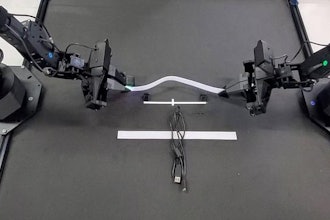
How can the cloud help businesses improve their electronics lifecycle management? There are many ways to apply the cloud throughout the electronics lifecycle, from design to end-of-life processes. The leading benefits of adopting cloud-based technologies include increased visibility, improved scaling, automation capabilities and more.
Improved Collaboration
Collaboration is vital in today’s electronics manufacturing industry. Every stage of the product lifecycle can benefit from improved creativity and communication. The cloud can help businesses foster innovation and get ahead of today’s supply chain challenges by improving collaboration.
For example, cloud-based design tools allow remote teams from all over the world to design new products together. Through the cloud, electronics developers can build the best possible team for their R&D department without the limitations of geography. Plus, cloud-based design tools allow everyone to view and edit the most up-to-date version of a design in real-time.
These factors can result in higher-quality end products. Collaboration through the cloud can also lead to more creative solutions to today’s challenges. For instance, a highly connected remote design team might be better equipped to find an alternative to an unavailable component or redesign a product so it is easier to recycle.
Research shows that only 12.5% of e-waste is recycled today while the rest makes up 70% of the world’s toxic waste. That means finding more sustainable ways to design electronics is one of the most pressing challenges in today’s electronics lifecycle. Businesses can use the cloud to foster maximum creativity and collaboration so their teams can tackle issues like this.
Increased Supply Chain Visibility
One of the top benefits of cloud-based tools in electronics lifecycle management is improved visibility. In today’s supply chain, delays and shortages are often the result of a lack of information and accurate, timely data. Low visibility leaves businesses ill-equipped to find and resolve weak links in their supply chain.
The cloud can resolve this issue by improving access to data. For example, businesses can use tech like IoT sensors and RFID tracking to monitor goods through the cloud as they move through the supply chain. The cloud also makes it easier to collect data from many sources into one hub. For instance, businesses can pool data from the R&D team, manufacturing, consumer research and supply chain monitoring into a unified data set stored in the cloud.
Improved supply chain visibility has a few essential benefits for businesses. It is a game changer for dealing with the ongoing effects of supply chain delays and shortages. Supply chain challenges can lead to a number of serious issues. For instance, counterfeit electronics and price inflation are a much more common risk when electronic components are in short supply.
Without good supply chain visibility, businesses might not realize they are purchasing counterfeit components or paying more than the fair market value. Low-quality components can throw off the entire electronics lifecycle due to poor performance and reliability. Using the cloud to improve visibility through greater access to data can help businesses verify the legitimacy of every supplier and distributor they work with.
Easier Scalability
Business growth is always exciting, but it can create unique challenges in the electronics lifecycle. For example, manufacturers may struggle to adapt to handle higher throughput.
The cloud can provide much-needed support in the electronics lifecycle during scaling. For example, cloud-based data and filing systems can make it easier to collaborate with international supply chain partners during the manufacturing process.
The cloud can even give businesses more flexibility in the manufacturing process itself. When an electronics business is trying to scale up its product offerings, it is often ideal to start with smaller orders of new products. Doing this with established manufacturing partners can be difficult, particularly if they are used to producing large-volume orders.
Instead, businesses can work with cloud manufacturers. This emerging approach to the manufacturing process uses cloud computing to offer remote, on-demand manufacturing services. It is a Manufacturing-as-a-Service model that’s ideal for small orders with quick turnaround times.
This is a great solution for electronics businesses that are adding a new product to their lineup. They can outsource the production of small batches of new devices without interrupting the production of existing products. Cloud manufacturing is agile and flexible enough to make it easy for businesses to pivot if they need to during the scaling process.
Automation and Cloud Computing
Cloud computing is one of the most exciting uses for the cloud in electronics lifecycle management. Businesses can use it to address several of the leading challenges in today’s electronics industry such as supply chain management, demand forecasting and automation.
Cloud computing allows businesses to reduce their on-premises computing costs while also gaining access to more computing power. The cloud can improve cybersecurity, as well, which is particularly important in the research and design phases of the product lifecycle. Businesses can use private cloud environments to gain the benefits of cloud computing without the risks of a public cloud.
Cloud computing can act as the foundation for cloud-based tools such as supply chain monitoring, remote design apps and demand forecasting tools. Through the cloud, businesses have access to more computing power at a lower cost, which allows them to run more advanced simulations and analytics programs.
This process is invaluable for predicting demand and supply chain activity. With accurate forecasting, electronics developers can stay well ahead of delays, shortages and market changes. It allows for a more informed, reliable product development lifecycle.
Now is the time to adopt cloud computing. Business usage of cloud data storage doubled between 2015 and 2022 and continues to grow.
Monitoring Component Health
The end-of-life stage of the electronics lifecycle has become one of the industry’s leading concerns. E-waste poses a serious environmental and public health issue around the world. So, finding better ways to handle electronics after their usable life span has never been more important.
Businesses can use the cloud to monitor devices’ and components’ mechanical health, which can help predict exactly when a device will be unusable or obsolete. This information is helpful for users, but it can also support more informed electronics recycling.
Understanding and monitoring the quality of every electronic component is crucial for building a more sustainable electronics lifecycle. Used electronics have valuable metals and materials in them that businesses can often reuse or recycle, which can reduce raw materials costs. So, designing products for easy refurbishment and recycling can be beneficial for everyone.
Cloud-Based Electronic Lifecycle Management
The cloud is transforming electronic lifecycle management. It can improve collaboration, increase computing capabilities, simplify scaling, increase visibility and support more sustainable electronics development. Making the jump to the cloud allows electronics businesses to build more reliable, sustainable supply chains and deliver higher-quality devices to their customers.























